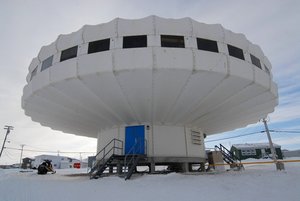Igloolik Research Center

Address
Department of Environment,Government of Nunavut,
Po Box 209, Igloolik,
NU, X0A 0L0 Canada
Station manager
Lynda ormanContact Station
http://env.gov.nu.ca/wildlife/resourcesStation Features
Opening year: 1975 Status: OpenFacilities
Station name and owner
The Igloolik Research Center is owned by the Department of Environment of the Government of Nunavut, CANADA.
Location
The Igloolik Research Center (IRC) with its main building with offices and laboratories, as well as warm and cold warehouses is located in the hamlet of Igloolik, Nunavut, Canada (69°22’ N, 81°48’W). The center is located on a small island at the northern tip of the Foxe Basin, in between the continent and the large Baffin Island. Additional facilities include stations in Kugluktuk (67°49’ N, 115°06’ W), Arviat (61°06’ N, 94°03’ W), Pond Inlet (72°41’ N, 77°57’ W), and Iqaluit (63°44’ N, 68°31’ W).
Climate data
Grey colours are WMO Climate Normals including maximum and minimum values. Blue colours are individual years.
Climate data for the stations where extracted via Copernicus Climate Data Store, from the global gridded reanalysis product:
ERA5 monthly averaged data on single levels from 1940 to present.
Description and source code: Roemer J.K. 2023. https://doi.org/10.5281/zenodo.10214922
Data Source: Hersbach et al. 2023. Copernicus Climate Change Service (C3S) Climate Data Store (CDS), https://doi.org/10.24381/cds.f17050d7
Biodiversity and natural environment
Igloolik is located in the tundra zone and is part of the northern arctic ecozone. Snow cover usually remains from September to June. Extremely low temperatures are common (-30°C as a mean temperature during winter month). The average precipitation per year is c. 280 mm. Much of the landscape is composed of barren plains covered by frost-patterned soils and rock outcrop. This area is rich in sea mammals and seabirds, with charismatic polar bears, belugas, and killer whales. The terrestrial wildlife includes in particular caribou (although declining in abundance), Arctic foxes, several waterfowl species, snow geese, falcons, and lemmings.
History and facilities
The facility was established by the federal government of Canada in the early 1970s to strengthen research in the Eastern Canadian Arctic. Within the main building, eight offices and two labs lead radially from a central area used for meetings. The research centre supplies local transportation with trucks, snowmobiles, sledges, boats with outboard motors, and ATVs all stored in a warm and a cold warehouse. Biologists, social scientists, and technicians of the Department of Environment, conduct research on a variety of terrestrial wildlife and management issues.
General research and databases
Research focuses on terrestrial wildlife and habitats with a special mandate on species directly linked to the traditional life of Inuit, i.e. caribou, polar bears, and muskoxen. The main research objectives of the station are to provide up-to-date information from various sources, including in-house scientific research and Inuit Qaujimajatuqangit, to co-management partners in order to make responsible wildlife management and land use decisions. Existing data bases include reports and publications arising from research at the station, climate records, terrestrial wildife survey and trends, as well as habitat mapping, wildlife monitoring, and ecosystem modelling.
Station Monitoring
Human dimension
Nunavut is the newest territory in Canada and is one of the most remote and sparsely populated regions in the world. It covers a large area of c. 2 millions km2. The Igloolik hamlet is located almost centrally in Nunavut and harbores approximately 1600 inhabitants (1/20 of the total population in Nunavut). The traditional Inuit culture still plays a major role in the daily life. Fishing and hunting is very important to local residents, all year round, focusing in particular on caribous, polar bears, seals, and beluga whales.
Access
During the summer, there are commercial plane and boat services available to reach the station. Regular flights are available from Iqaluit (Nunavut capital), which is connected every day to Montreal and Ottawa. For local transportation the center offers logistical support to researchers working on site and in the larger area. This includes snowmobiles, a 4×4 truck, ATVs, and boats.

